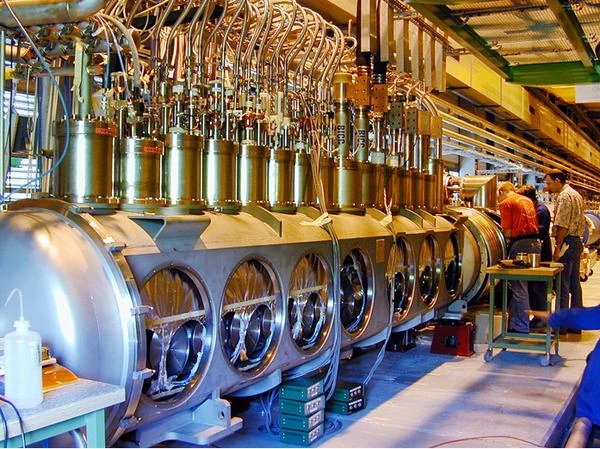
The LHC (Large Hadron Collider) is the most powerful and complex particle accelerator ever built by humanity. Located on the Franco-Swiss border, it represents the culmination of decades of research in particle physics. Its primary goal is to test the predictions of various particle physics theories, particularly the Standard Model, and to advance our understanding of the fundamental laws governing the universe.
| Accelerator | Collision Energy (TeV) | Circumference (km) | Year of Commissioning | Accelerated Particles |
|---|---|---|---|---|
| LHC (CERN) | 13.6 | 26.7 | 2008 | Protons, heavy ions |
| Tevatron (Fermilab) | 1.96 | 6.3 | 1983 | Protons, antiprotons |
| RHIC (Brookhaven) | 0.5 | 3.8 | 2000 | Heavy ions, protons |
| LEP (CERN) | 0.209 | 26.7 | 1989 | Electrons, positrons |
Source: CERN - Large Hadron Collider and U.S. Department of Energy.
The LHC is unique in its monumental scale. Installed in a circular tunnel with a circumference of 26.7 kilometers, it uses cutting-edge technologies to accelerate protons to record energies of 6.8 TeV per beam, resulting in a collision energy of 13.6 TeV in the center of mass. To achieve this performance, particles circulate in an ultra-high vacuum environment, similar to that found in interplanetary space, and are guided by superconducting magnets cooled to a temperature of -271.3°C (1.9 K), colder than outer space.
Four main detectors (ATLAS, CMS, ALICE, and LHCb) analyze proton-proton collisions. ATLAS and CMS, the two general-purpose detectors, are among the largest machines ever built. They measure approximately 25 meters in height, 45 meters in length, and weigh over 7,000 tons each. These detectors must record up to one billion collisions per second, a colossal computational and technological challenge that required the development of revolutionary triggering and data analysis systems.
The LHC's most famous contribution is the discovery of the Higgs boson in 2012, a theoretical prediction formulated in the 1960s by Robert Brout (1928-2011), Peter Higgs (1929-2024), and François Englert (1932-2023). This particle confirms the existence of the Higgs field, which is responsible for the mass of elementary particles. Beyond this iconic discovery, the LHC has enabled significant advances in many areas: study of quark-gluon plasma, discovery of new hadronic particles, and research into physics beyond the Standard Model, such as supersymmetry or dark matter.
N.B.:
The Higgs boson, discovered in 2012 at the LHC by the ATLAS and CMS experiments, is a scalar particle (spin 0) with a mass of about 125 GeV/c2. Theorized in 1964 by François Englert, Robert Brout, and Peter Higgs, it is the quantum excitation of the Higgs field, responsible for the mechanism that gives mass to elementary particles. Its discovery confirmed the electroweak symmetry breaking and earned Englert and Higgs the 2013 Nobel Prize in Physics.
The LHC is the result of an unprecedented international scientific collaboration. Over 10,000 scientists and engineers from more than 100 countries participate in the experiments. This collaboration transcends political and cultural borders, illustrating humanity's ability to unite around a fundamental knowledge project. The construction budget amounted to approximately 4.6 billion euros, shared among the member states of CERN and other contributing countries.
The development of the LHC has led to major innovations in various technological fields. Superconducting magnets, ultra-high vacuum systems, particle detectors, and distributed computing systems have pushed the boundaries of engineering. These advances have concrete applications in other fields such as medicine (medical imaging, hadron therapy), computing (massive data processing), and superconducting materials.
The LHC continues to evolve with the HL-LHC (High-Luminosity LHC) program, which will significantly increase the number of collisions starting in 2029. This upgrade will allow ten times more data to be collected, offering increased sensitivity to detect rare phenomena and potentially discover new physics. Meanwhile, the scientific community is already planning even more ambitious successors, such as the Future Circular Collider (FCC) with a circumference of 100 km.